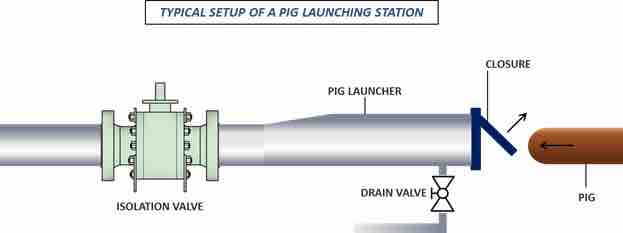June 2016, Vol. 243, No. 6
Features
Hydraulic-Assisted Seat Designed for Superior Sealing Capability

Operators invest heavily in energy-delivering systems such as pipelines in order to ensure that demands of the global energy industry are met in a safe and reliable way. A pipeline has integrity when it reduces the chance of failure during operation and maintenance, and minimizes the consequential risks to people, environment and the pipeline operators.
Valve integrity plays a major role in guaranteeing the overall viability of the pipeline. Valve leakage is a credible threat that can be costly to operators. Not only is there the cost resulting from repairing the valve, but also lost profit due to pipeline downtime and legal repercussions for environmental damage.
Ball valves equipped with an emergency sealant injection are the traditional way of mitigating risk of leakage to the atmosphere. This port is used to inject a sealant to temporarily restore the sealing capability of the valve. However, this feature is useful only after the soft seat inserts of the valve are damaged and require replacement.
Therefore, areas of the pipeline requiring critical isolation need engineered valves with specialized features that not only minimize damage to soft seat inserts, but are also capable of providing leakage-free performance.
Critical Areas
Pig-launching and receiving stations of the pipeline are essential parts of the energy-delivery system that require valves with superior sealing performance. Pigs are devices that perform cleaning, inspection and maintenance operations.
The pigging operation is carried out by closing the isolation valve at the launcher station in order to stop the flow through the pipeline toward the pig-launcher station. The drain and vent valves are then opened in order to remove the remaining medium within the pig-launcher chamber.
Once the chamber is completely drained, the pig-launcher closure door is opened and the pig is inserted and propelled through the pipeline using the pressure-driven flow of the pipeline medium.
The pig collects debris while traveling through the length of the pipeline and pushes it toward the pig-receiver station. At the station, the isolation valve is closed again and the receiving chamber is drained to ensure that the pig-receiver door can be safely opened to remove the pig and collected waste.
The isolation valve and its capability to seal effectively play a critical role in ensuring that the pigging operation is carried out successfully. The isolation valve in closed position allows the opening of the launcher closure in a safe manner by sealing and stopping the flow of medium (gas/liquid). If the sealing capability of the valve installed at the launcher station is compromised, this would cause the pipeline medium to continue its flow toward the pig-launcher chamber.
This would make the opening of the launcher closure extremely dangerous because of the buildup of pressure within the chamber, possibly even resulting in serious injury or explosion of the pig-launching station. This holds true for the pig-receiver station as well. In either case the failure of a valve to successfully seal leads to compromising the integrity of the pipeline.
Hydraulic-Assisted Seats
The ball valve seating arrangement is a feature that contributes significantly to the sealing capability of a valve. Due to constant contact between the sealing surfaces during the opening and closing operation, valves risk damage to internal components, which reduces the life of the product and can lead to unexpected outages and unplanned maintenance. It is, therefore, critical to choose a seating arrangement that mitigates potential seat damage and optimizes the sealing capability of the valve.
The hydraulic-assisted seat is an innovative feature incorporated in side-entry and top-entry trunnion-mounted-ball valves manufactured by Flowserve-Valbart, headquartered in Italy. This feature enables automatic retraction of the seats, caused by hydraulic pressure through activation of the hydraulic function (manually or automatically from the actuator), ensuring the valve-sealing surfaces are not in contact during valve operation.
This reduces wear and tear on critical sealing components as well as reducing the actuator torque required to operate the valve. Sealing is achieved again by releasing the hydraulic pressure, which pushes the seats against the ball with the help of the spring load.
When the valve is in the closed position, the seat is automatically activated by the pressure in the line and performs the required sealing action. The sealing of the valve can be obtained in single-piston effect (through pressure coming from the line) or in double-piston effect (through pressure coming from the valve cavity).
Upon activating the hydraulic-assisted seats mechanism, the hydraulic pressure enables the retraction of the seats and results in the pressure load on the seats to be removed with or without pressure in the pipeline. This enables the ball to be opened freely during complete stroke. The hydraulic-assisted seat mechanism can be activated using the pressure coming automatically from the actuator.
Once the hydraulic pressure is released, the seats are pushed back in contact with the ball with the help of the spring load, and positive sealing is achieved. The seat retraction action can also be activated before the closing operation of the valve.
In case of leakage caused by damage to soft inserts, hydraulic-assisted seats can help regain the sealing capability of the valve. This can be done through the manual activation of the mechanism using a pump. The hydraulic pressure is introduced into the seat room which causes the seat to be pushed in contact with the ball.
This reinstates the sealing between the ball and the seat and closes the damage caused. If desired, the activation of the mechanism can be done through a manual pump. This is an alternative to the standard sealant grease injection operation.
In summary, hydraulic-assisted seats improve the life span of valves through minimized wear and tear of internal components, and in turn, improve pipeline integrity through reliable leakage-free performance.
Authors: Giuseppe Vignati is director of Engineering, Application Engineering and R&D at Flowserve and has over 30 Years’ experience in the oil and gas. He is manages and coordinates of all the technical areas with responsibility of Planning, Design and Calculation.
Vijith Basheer is responsible for creating and implementing go-to-market strategies for pumps, valves, seals and aftermarket services for oil and gas, chemical and power markets.







Comments